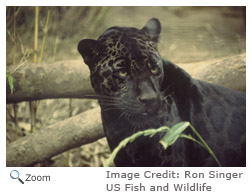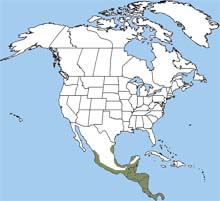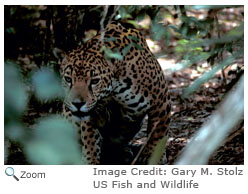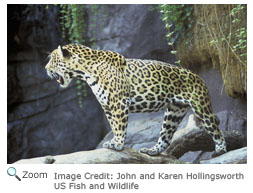Characteristics
 The jaguar is the largest cat in North America and the third largest cat in the world. It stands about three feet tall from shoulders to feet, 6½ to 7½ feet long from nose to tail and weighs between 100 and 250 pounds. It has a stocky body and a big head. Its coat is golden-brown with clusters or groups of black spots that look like rosettes. The jaguar is the largest cat in North America and the third largest cat in the world. It stands about three feet tall from shoulders to feet, 6½ to 7½ feet long from nose to tail and weighs between 100 and 250 pounds. It has a stocky body and a big head. Its coat is golden-brown with clusters or groups of black spots that look like rosettes.
 The spot pattern is a small group of spots circled by a larger group of spots. It has single spots on its head, legs and tail. It has white fur on its undersides, on its chest and under its nose. Sometimes a jaguar is completely black. Black jaguars still have spots; they are just very difficult to see. The spot pattern is a small group of spots circled by a larger group of spots. It has single spots on its head, legs and tail. It has white fur on its undersides, on its chest and under its nose. Sometimes a jaguar is completely black. Black jaguars still have spots; they are just very difficult to see.
Range
 The jaguar can be found in Texas, New Mexico and Arizona and from Mexico to Patagonia. It is extremely rare in the United States and is a federal endangered species. The jaguar can be found in Texas, New Mexico and Arizona and from Mexico to Patagonia. It is extremely rare in the United States and is a federal endangered species.
Habitat
The jaguar makes its home in a wide variety of habitats including
deciduous
forests, rainforests, swamps,
pampas grasslands and mountain scrub areas.
|
|
Diet
 The jaguar is a carnivore. It hunts mostly at night. Its prey includes capybara, peccaries, deer, large ground birds, fish, snakes, turtles and rabbits. It will also eat livestock like horses, cows and sheep. The jaguar hunts mostly on the ground, but it sometimes climbs a tree and pounces on its prey from above. The jaguar has very powerful jaws and sharp teeth and usually kills its prey with one crushing bite to the skull. The jaguar is a carnivore. It hunts mostly at night. Its prey includes capybara, peccaries, deer, large ground birds, fish, snakes, turtles and rabbits. It will also eat livestock like horses, cows and sheep. The jaguar hunts mostly on the ground, but it sometimes climbs a tree and pounces on its prey from above. The jaguar has very powerful jaws and sharp teeth and usually kills its prey with one crushing bite to the skull.
Life Cycle
Jaguars mate year-round. About 100 days after mating the female has one to four kittens. She will give birth in a cave den or a thicket. The kittens are born with their eyes closed. At birth they have fuzzy spotted fur. The kittens begin to hunt when they are six months old. They will stay with their mother for about two years.
The jaguar has a lifespan of 15-20 years.
Behavior
 The jaguar is a solitary animal and lives and hunts alone, except during mating season. The male's homerange is
between 19 to 53
square miles. The female's homerange is
between 10 to 37
square miles. A male jaguar may share his home range with several females. He will aggressively protect his homerange from other males to ensure that any females in his territory mate only with him. The jaguar is a solitary animal and lives and hunts alone, except during mating season. The male's homerange is
between 19 to 53
square miles. The female's homerange is
between 10 to 37
square miles. A male jaguar may share his home range with several females. He will aggressively protect his homerange from other males to ensure that any females in his territory mate only with him.
The Jaguar, unlike most big cats, loves the water. It often swims, bathes and plays in streams and pools. It will also hunt for fish in the water.
|